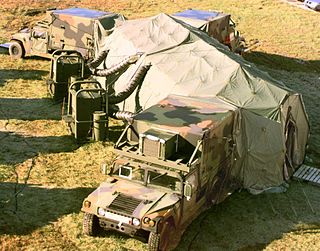
The Direct Air Support Center (DASC) is the principal United States Marine Corps aviation command and control system and the air control agency responsible for the direction of air operations directly supporting ground forces. It functions in a decentralized mode of operation, but is directly supervised by the Marine Tactical Air Command Center (TACC) or the Navy Tactical Air Control Center (NTACC). During amphibious or expeditionary operations, the DASC is normally the first Marine Air Command and Control System (MACCS) agency ashore and is usually categorized as the Ground Combat Element's (GCE's) senior Fire Support Coordination Center (FSCC). The DASC's parent unit is the Marine Air Support Squadron (MASS) of the Marine Air Control Group (MACG).
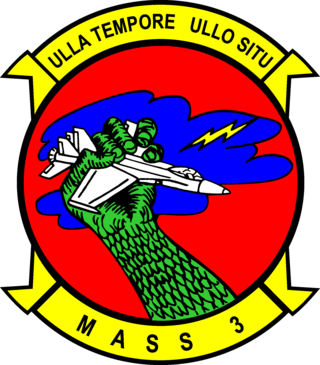
Marine Air Support Squadron 3 (MASS-3), is a United States Marine Corps aviation command and control unit that provides the Direct Air Support Center (DASC) for the 1st Marine Expeditionary Force. They are based out of the 32 Area on Marine Corps Base Camp Pendleton, California and fall under the command of Marine Air Control Group 38 and the 3rd Marine Aircraft Wing.

Marine Heavy Helicopter Squadron 462 (HMH-462) is a United States Marine Corps helicopter squadron operating CH-53E Super Stallion heavy transport helicopters. The squadron, known as the "Heavy Haulers", is based at Marine Corps Air Station Miramar in California and falls under the command of Marine Aircraft Group 16 (MAG-16) and the 3rd Marine Aircraft Wing.
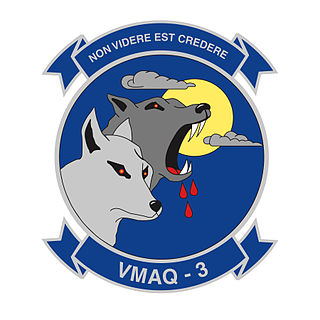
Marine Tactical Electronic Warfare Squadron 3 (VMAQ-3) was one of four Tactical Electronic Warfare Squadrons in the United States Marine Corps. The squadron consisted EA-6B Prowler jets and was tasked with conducting airborne electronic warfare. The squadron was based at Marine Corps Air Station Cherry Point, North Carolina and fell under the command of Marine Aircraft Group 14 (MAG-14) and the 2nd Marine Aircraft Wing. The squadron was decommissioned on 11 May 2018 as the Marine Corps sunsets the EA-6B Prowler.
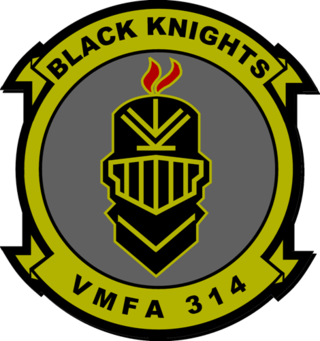
Marine Fighter Attack Squadron 314 (VMFA-314) is a United States Marine Corps F-35C Lightning II squadron. The squadron, known as the "Black Knights", is based at Marine Corps Air Station Miramar, California and falls under the command of Marine Aircraft Group 11 (MAG-11) and the 3rd Marine Aircraft Wing, but deploys with the US Navy's Carrier Air Wing Nine (NG).
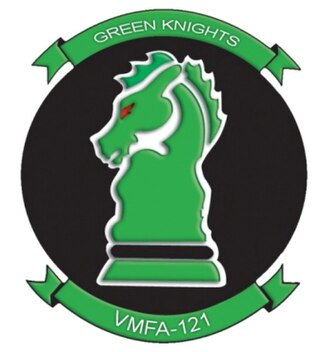
Marine Fighter Attack Squadron 121 (VMFA-121), also known as the "Green Knights", is a United States Marine Corps aircraft squadron operating the F-35B Lightning II. The squadron is based at Marine Corps Air Station Iwakuni, Japan and falls under the command of Marine Aircraft Group 12 (MAG-12) and the 1st Marine Aircraft Wing. Their tail code is VK and their radio call sign is "Combat".

Marine Air Support Squadron 2 (MASS-2), is a United States Marine Corps aviation command and control unit that provides the Direct Air Support Center (DASC) for the III Marine Expeditionary Force. It is the oldest and most decorated aviation command and control unit in the Marine Corps.

Marine Air Support Squadron 1 (MASS-1) is a United States Marine Corps aviation command and control unit that provides the Direct Air Support Center to coordinate close air support for the II Marine Expeditionary Force. Callsign "Chieftain," the squadron is based out of Marine Corps Air Station Cherry Point, North Carolina, and falls under the command of Marine Air Control Group 28 and the 2nd Marine Aircraft Wing.

Marine Aircraft Group 13 is a United States Marine Corps aviation unit based at Marine Corps Air Station Yuma that is currently composed of one McDonnell Douglas AV-8B Harrier II squadron, three Lockheed Martin F-35B Lightning II squadrons, an unmanned aerial vehicle squadron, a maintenance and logistics squadron, and a wing support squadron. The group falls under the command of the 3rd Marine Aircraft Wing and the I Marine Expeditionary Force.

The Marine Wing Support Squadron 373 is an aviation ground support unit of the United States Marine Corps. They are based out of Marine Corps Air Station Miramar, California. The squadron is part of Marine Air Control Group 38 and the 3rd Marine Aircraft Wing.

Marine Air Support Squadron 6 (MASS-6), is a reserve United States Marine Corps aviation command and control unit that provides the Direct Air Support Center (DASC) for the Marine Forces Reserve. Their headquarters is in Westover Air Reserve Base, Massachusetts and their Detachment Alpha is located at Marine Corps Air Station Miramar, California

Marine Air Control Group 28 (MACG-28) is a United States Marine Corps aviation command and control unit based at Marine Corps Air Station Cherry Point that is currently composed of four command and control squadrons and a low altitude air defense battalion that provide the 2nd Marine Aircraft Wing with airspace coordination, air control, immediate air support, fires integration, air traffic control (ATC), radar surveillance, aviation combat element (ACE) communications support, and an integrated ACE command post in support of the II Marine Expeditionary Force.
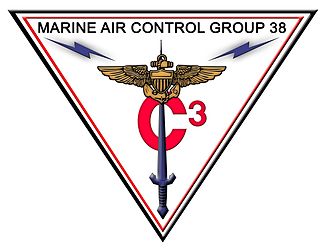
Marine Air Control Group 38 (MACG-38) is a United States Marine Corps aviation command and control unit based at Marine Corps Air Station Miramar that is currently composed of four squadrons and one battalion that provide the 3rd Marine Aircraft Wing's tactical headquarters, positive and procedural control to aircraft, and air defense support for the I Marine Expeditionary Force.

Marine Aviation Logistics Squadron 13 (MALS-13) is an aviation logistics support unit of the United States Marine Corps. Known as the "Black Widows", it is currently based at Marine Corps Air Station Yuma, as part of Marine Aircraft Group 13 and the 3rd Marine Aircraft Wing.
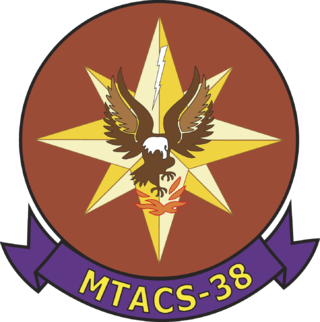
Marine Tactical Air Command Squadron 38 (MTACS-38) was a United States Marine Corps aviation command and control unit that provided the Tactical Air Command Center (TACC) for the 3rd Marine Aircraft Wing. The TACC is the senior agency in the Marine Air Command and Control System (MACCS) and serves as the operational command post for the commander of the aviation combat element and their staff. The squadron was based at Marine Corps Air Station Miramar, California and fell under the command of Marine Air Control Group 38 and the 3rd Marine Aircraft Wing.

Marine Air Support Squadron 4 (MASS-4) was a reserve United States Marine Corps aviation command and control unit that provided the Direct Air Support Center (DASC) capability from 1962 through the early 1990s. MASS-4 was headquartered at Naval Air Station Los Alamitos, California, and was part of Marine Air Control Group 48 (MACG-48) and the 4th Marine Aircraft Wing.

Marine Air Control Squadron 3 (MACS-3) was a former United States Marine Corps aviation command and control squadron. During its later years it also served as an operational test and evaluation squadron. Originally formed in World War II as Air Warning Squadron 12 (AWS-12), its original mission was to provide aerial surveillance and ground-controlled interception (GCI) for Marine Corps forces during amphibious operations. The squadron did not participate in combat operations during WWII however it did deploy and operate during the Korean War. In 1961, MACS-3 was transferred from the Fleet Marine Force to the administrative control of Air, Fleet Marine Forces Pacific in order to serve as the operational test and evaluation squadron for what was at the time, the largest research and development project in the Marine Corps - Marine Tactical Data System (MTDS). After MTDS testing was complete the Marine Corps recognized that it was not properly staffed to develop, test, and acquire new digital equipment. On 1 July 1970, MACS-3 was decommissioned and its structure and equipment were utilized to form Marine Corps Tactical Systems Support Activity (MCTSSA) at Marine Corps Base Camp Pendleton, California. Of note, MCTSSA does not carry MACS-3's lineage and honors.
Marine Air Traffic Control Units (MATCU) were United States Marine Corps air traffic control (ATC) detachments that provided continuous, all-weather, radar and non-radar, approach, departure, enroute, and tower ATC services at both garrison Marine Corps Air Stations and tactical airfields when deployed. MATCUs possessed Tactical air navigation systems (TACAN) and Ground-controlled approach (GCA) equipment which assisted Marine Corps, joint and coalition aircraft in conducting landings during inclement weather. During the Vietnam War, numerous MATCUs served throughout the I Corps Tactical region of South Vietnam supporting the III Marine Amphibious Force. Beginning in the mid-1970s, the Marine Corps decided to consolidate regionally aligned MATCUs into Marine Air Traffic Control Squadrons. The last reserve MATCU was decommissioned in 1980.
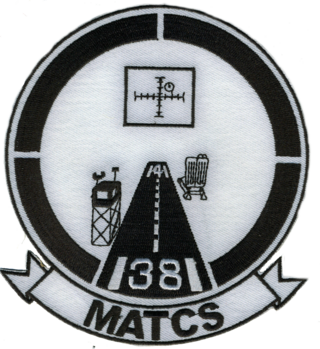
Marine Air Traffic Control Squadron 38 (MATCS-38) was a United States Marine Corps aviation command and control squadron responsible for providing continuous, all-weather air traffic control services for the 3rd Marine Aircraft Wing throughout the West Coast of the United States. MATCS-38 was formed by consolidating four, regionally aligned Marine Air Traffic Control Units under one flag to better integrate them with the Marine Air Command and Control System. The squadron was headquartered at Marine Corps Air Station Tustin, California and fell under the command of Marine Air Control Group 38. MATCS-38 was decommissioned in September 1994 and its air traffic control function were transferred to Marine Air Control Squadron 1. Since its decommissioning, no other squadron has carried the lineage and honors of MATCS-38.




















